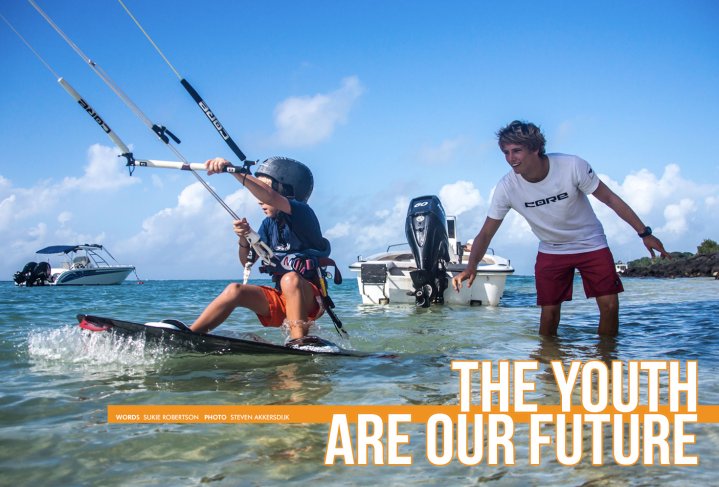
The Youth Are Our Future
Issue 59 / Thu 13th Oct, 2016
Our sport is safer than ever right now, and there has never been a better time to get younger riders into our kitesurfing. Sukie Robertson looks at the best way to go about inspiring and encouraging kids to get hooked in…
Kitesurfing and kids go together like peas and carrots, fish and chips and Guinness and the Irish. As adults, we all know how fantastic our sport can be, but getting your kids involved can often seem daunting. However, if you take the plunge the rewards are endless, more time on the water for one, a healthy lifestyle garnered from a young age, and the chance to be really, really good at something by the time they are old enough to have a beer in the pub after a session…
Right now, kitesurfing has never been safer. Incredibly simple, quick releases, cutting edge design and also top coaching have resulted in people learning to kitesurf and be self-sufficient in under 10 hours. Safety has always been the main reason people, or rather, parents, were reluctant to get their children into kiting. The risks borne out by the sport in the “good old days” have been eliminated by modern safety systems and improved knowledge. Now the benefits of teaching children to kitesurf are so great they far outweigh any negatives.
How do you go teaching your loved one the greatest sport on the planet, though? Generally speaking, a traditional 3-day course would simply be too much at one time for kids under 15. Not only in terms of muscle endurance but also the sheer amount of information having to be taken in in such a short period.
Children learn a lot better in small chunks using as much practical method as possible. In fact, the best way to get children initially started is with a small 2-3 meter trainer kite and have them fly this at every opportunity. Not only will this teach them about the wind, which is essential, it will also encourage "playtime with a kite", which is a great attitude in kitesurfing.
Once you’ve got to this stage, there are a couple of options. Various kite schools will teach children while the parents are present, in clubs or traditional lessons. The alternative to proper lessons would be teaching them yourself. As with all things, learning something from someone close to you can sometimes be a recipe for disaster, kitesurfing is no different. Of course, it is fundamental that parents know the basics to assist, but you don't have to teach them, and often they will respond far better to a professional instructor than they will their mum and dad...
What is essential with choosing a school is checking they supply specific children’s equipment. Harnesses, wetsuits and buoyancy aids need to be well fitting, and kites, boards and straps must be of a suitable size. Many brands now do kid specific gear, and a school that has this gear should have experience of teaching children.
The UK specifically it seems has some incredibly exciting and encouraging projects going on for youths. Two kite schools within the south-west have started ‘Kids Clubs’ which allow children aged between 10 and 18 to experience kitesurfing with their peers.
Edge Watersports, famous for the incredibly successful Bridge family, started their courses last year and have a thriving youth scene. No stranger to teaching children, Steph Bridge taught her three sons Ollie, Guy and Tom to kitesurf when they were very young, and they are now at the pinnacle of their chosen disciplines.
Why a club rather than traditional lessons? Simply put, Steph says, “Children learn better with other kids, and the emphasis must be on fun. Playing games with kites makes good kiters and children play best with other children.”
Edge and North Kiteboarding go hand in hand, and the reintroduction of the ‘Young Blood Project’ has been great for all the kids on the course. North have recognised that finances play a huge part in a parents decision to get their child kitesurfing, so have offered a limited amount of youth friendly packages at half the RRP. When you consider that for a second, it’s a huge saving and a superb way to encourage parents to push their children into kitesurfing.
Just up the coast, my kite school has three different clubs to suit different levels. 514Elemental Kitesports have been running their clubs for three years and not only teach kitesurfing but land kiting too. Robin Snuggs and I both started kiting as children ourselves so we know first hand the battles that are faced.
We have a huge beach, which is perfect for land boarding and buggying, and this is now a prerequisite for any child wishing to enter the water through our clubs. The more time anyone spends on a kite, the better, and for children in particular, if things become second nature then everything is more fluid.
Once kids learn to buggy and landboard, they learn the same movements used in kitesurfing, how it feels to be generating power and the angles they can achieve into the wind. Once they head into the water, their progress is very quick, and no thought on the child's behalf really goes into the kite. Fundamental to all kids sessions is praise and fun. The simplest thing can be worthy of a ‘good job’ or ‘really well done’ and kids respond well to praise. They try harder and get better results.
Of course, not many places have the facilities to teach these land based sports, but what is important is how much longer these kids spend on the trainer kites resulting in top kite skill. After all, kitesurfing is just flying a kite stood on a board! The great thing about a club is that the coaching continues long after the riding has begun. The constant coaching and riding with peers will keep the juniors progressing and riding to a high level.
If you have access to one of these clubs, and more are popping up all the time; then we can only encourage you to join in. A child will stay with kiting if their friends do it. If kiting is something they only do with their dad and friends, then there is a danger they will be more influenced by their friends at school playing Pokémon Go or whatever the latest fad amongst their peers and friend and they will lose interest.
If there are none near you, you could always ask your local school to start one up. If there are enough juniors, then it makes sense for the school to push the club and one will start. If there are no schools, then why not get your kiting friends kids involved too. The most important factor for success is that there are other young riders on the beach so the children can interact and have fun on their level…
Many schools worldwide run camps, great weeklong events which produce great friendships with kitesurfing at their core. These are often attended by high profile kitesurfers who started themselves as juniors and will be a great inspiration. These are also worth a Google search for and can be a fantastic way to spend a week or so of the summer holidays!
Kit wise, as we all know you need equipment that fits you and how you ride. A junior harness for the smaller kids is essential to deter any later back pain. Helmets are a given. As adults, we don’t always use them ourselves, but there is no excuse for juniors not to be wearing them, really we all ought to be leading by example, but that is a whole other subject!
There are junior specific boards, which are great when kids are small and just cannot manoeuvre a big board. Many brands now include these in their ranges and they hugely aid juniors when they ride, arguably more than any other piece of equipment. Almost more important though are the foot straps, you would be surprised but tiny sized 3 feet do not fit into adult straps although wearing booties can help to pad out the straps!
A couple of brands do now produce children's specific kites and bars, this is personal preference, but the throw of the bar should be of consideration. Younger riders have shorter arms, so they need to be able to depower the kite with a short throw of the bar. Otherwise, they will get out of control and overpowered too quickly.
Above all though, make sure that release is safe, safe, SAFE, and your child can eject without a moment's hesitation. Buy recent and buy safe. Don’t get something cheap off eBay from 5 years ago; this is your child’s life we are talking about!
Once your precious little one has paid their dues learning to ride and nailed their first few tricks, what happens next? For most riders, and children, in particular, competition is a natural progression. Most national event series have a junior category, and now there is even a separate world championship event for riders under 21 years old.
Most recently we have had the incredibly exciting inclusion of twin tip racing in the Youth Olympics in 2018; there is still plenty of time to get training for that!
Your national tour is a great place to start, and not only will competition push anyone, young or old, but it will inspire the riders to progress. Competitions are also an excellent way to meet other kids, their parents and coaches. For children, in particular, seeing another kid doing a trick will be the best inspiration out there, knowing size is no boundary. The Pro riders in each competition often started as juniors themselves and will be an excellent role model for your child to aspire to as well.
The British Kitesurf Championships, for example, has a great bunch of junior competitors, many of whom train with former women’s champion Jo Wilson. A professional kitesurfer herself, Jo set up her Jo Wilson Coaching business after a lack of coaching available for herself while competing. Through this, she has successfully set up the UK’s Youth Coaching Scheme which trains riders aged between 12 and 20 both on riding and also working as a professional rider. Coaching weekends are spread throughout the year allowing the Juniors to train and also then compete together. Many of these riders have even gone on to ride in international events.
On a larger scale, F-ONE kiteboarding has been brilliant in their encouragement of young riders. Etienne L’Hote runs their "Next Generation" team, whose competition successes far outweigh the age of many of their riders. These young riders attend an intensive training camp, which focuses on riding and competition training, media and what it is to be a professional rider. Their current crop is truly phenomenal at kitesurfing!
Of course for some people kiting at the weekends and holidays is just not enough. That’s where the World Class Kiteboard Academy (WCKA) comes in. A true ‘Kite School’, kitesurfing and academia are side-by-side, day in day out. Based in the US, Lindsay McClure has been with the Academy since its inception in 2014. Mentor, coach and tutor, she explains how even just one semester can be catalytic in their in freestyle development.
"Students travel with the school to locations the world over, training in different conditions with different athletes at all times. It’s a pretty sweet way to learn your times tables! Luckily, the WCKA acknowledge kitesurfing should not be a reward for the wealthy and do offer various scholarships for those who feel they would benefit from this type of school but may not have the cash to offer their child the world."
After all of this coaching and competition, your superstar offspring is the next world champion. Or not. And it doesn't matter; the most important aspect in all of this is that kitesurfing stays fun and 'play like" for kids and that they enjoy being out on the ocean amongst the elements sharing your passion for the sport!
There is of course, no matter how safe the current equipment, an inherent risk in kitesurfing, which we cannot ignore, and it would be irresponsible of us to do so. No matter how experienced the rider, unfortunately, accidents do happen. Of course, they could happen to you or I or anyone. A child, who has the dedication and perseverance to learn to kitesurf, also has the commitment and determination to learn all safety aspects and how to minimise those risks as much as possible. Safety should always be the underlining factor of any session, checking the conditions, making “get out plans” and understanding their limitations is crucial.
Do we want our children growing up not experiencing anything because we deem it unsafe? I’m pretty sure more kids hurt themselves falling off swings than they do kiting. Children seem to have a natural understanding of risk and are often much more cautious than adults. As long as you instil good safety values, then you can manage as much of the risk that this sport offers easily and be as safe as possible.
Kitesurfing is, as we know, expensive. Of course, this is all relative, but to a child who may be too young to work it is out of their league. What we don’t want to happen is kiting to become an elitist sport. When choosing the lessons, many places do a discounted rate for Juniors, and of course teaching them yourselves only costs your water time.
Junior equipment is often cheaper, and hunt around and you can find some appropriate sized modern kit at a good price, with more young riders involved there is more equipment getting pushed into the second-hand market. Just make sure those safety systems are adequate, and the gear is suitable. We don’t want you to find an eBay classic and chuck your ten-year-old on it just because it's 6 meters and seems the right size, but small boards and harnesses do come along relatively often.
CORE rider Taylor Hall has an admiral outlook and describes how it is our duty as riders, and professionals, to encourage and help anyone as much as we can into our brilliant sport. Describing some of the young riders near him in Mauritius, he explains just how stoked they are to be out kiting at any time and enjoying being in the ocean. As a rider, he is encouraged to help juniors all he can with coaching and lending of kit.
Perhaps if we all did this once or twice, we could inspire an entirely new generation to kiteboard.
Right now, everything is geared towards kidskitesurfing. We have the safest equipment in our history, dedicated coaching, youth competitions and the Olympic Games on the horizon. Kitesurfing is the most fun they will ever experience just waiting to happen. You know just how fun it is, why would anyone ever want to hold that back from anyone else?
Videos
By Sukie Robertson


























